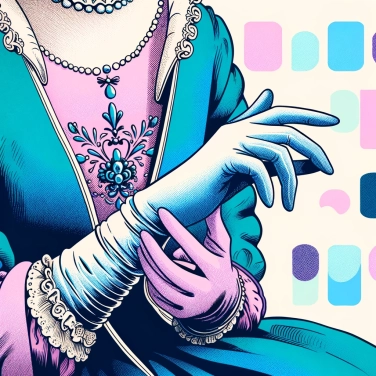Catherine de Médicis always wore gloves to conceal a physical anomaly: six fingers on each hand.

In the time of Catherine de Medici, wearing gloves was clearly an outward sign of wealth and a way to show who was in charge. For her, having a different pair for every occasion was essential to display her royal authority and refined taste. These accessories also served to impose her unique style, often imitated by the ladies of the court. Carefully chosen, her gloves were made from ultra-refined materials such as fine leather, silk, or lace, sometimes even adorned with precious embroidery or embedded with stones. These details spoke volumes about the social rank of the wearer. Catherine knew exactly how to play this game of appearances: her gloves told exactly the place she occupied within the royal court.
At that time, diseases such as plague, smallpox, or syphilis could wreak havoc. Catherine de' Medici was well aware of this; wearing scented gloves soaked in plant essences could limit the risk of infection or at least mask the unpleasant odors in the environment. It was believed that foul smells directly carried diseases. As a result, having hands that were always protected was a very common health habit, halfway between medical superstition and hygienic reality. Her scented gloves therefore played a role that was both practical and preventive in her anti-epidemic strategy.
Catherine de Medici was famous for often wearing gloves, particularly because in her time, fine, white, and impeccable hands were a true sign of beauty and nobility. However, she had some well-known physical complexes, including hands deemed less graceful according to the strict standards of the court. She used these accessories to hide these small imperfections and better align with the aesthetic ideals of her time. In an era where everything was scrutinized closely in royal courts, a simple glove could save the day and allow one to maintain elegance without anyone suspecting physical flaws. Some chroniclers even recount that she concealed blemishes or marks on her skin, which contemporaries found far from elegant. In short, her gloves were the perfect fashion trick to stay at the top among royalty.
Catherine de Medici was originally from Florence, Italy, where gloves were not just an accessory but almost a tradition. There, wealthy people had taken to wearing refined gloves made of fine leather or delicate silk, often scented with subtle fragrances. When Catherine arrived at the court of France, she brought with her these Italian habits that would directly influence the fashion of the country. She particularly introduced a taste for sophisticated gloves, adorned with embroidery, precious stones, or even soaked in perfumes to mask certain unpleasant odors. This immediately captivated the French nobility, who eagerly rushed to copy this new Italian trend brought by the queen. Catherine thus contributed to popularizing an Italian elegance at the French court that would leave a lasting mark on the history of fashion.
Wearing gloves at court wasn't just for style: it had a clear social function. At the time of Catherine de' Medici, a glove could become a true symbol of distinction. Wearing one was a testament to a person's rank, prestige, wealth, or even royal favor. Offering a glove or removing it in front of someone was also a way to send a pretty clear message: respect, challenge, seduction, or political alliance. The way someone held their gloves or wore them told a whole story without even uttering a word. The perfect object to subtly suggest one's status or intentions in the subtle games of power.
The glove-makers, very popular during the Renaissance, formed a powerful guild, and their elegant creations were a sign of high status at the royal court.
During the time of Catherine de' Medici, offering a glove was a powerful symbolic gesture, often interpreted as a sign of affection, a political alliance, or even a challenge to a rival.
Some gloves of the time were richly embroidered with luxurious materials such as gold, silver, or crushed gemstones, thereby adding an additional highly coveted luxury in high social circles.
Catherine de Médicis contributed to the spread of Italian practices at the French court, particularly by introducing the regular use of forks at the table, a habit that was still not widely adopted in France at that time.
Even though Catherine de Médicis was renowned for frequently wearing gloves, their systematic use mainly pertained to public appearances, official ceremonies, or formal social interactions for both aesthetic and hygienic reasons.
Yes, some historical collections and European museums today hold authentic or attributed examples of the gloves of Catherine de' Medici, showcasing the refined and sophisticated clothing practices of the 16th century.
In the time of Catherine de Medici, removing a glove in front of someone was a significant gesture of trust and social openness, often used to emphasize relational closeness, intimacy, or respect towards the interlocutor.
The gloves worn by Catherine de Medici were often made of fine leather or luxurious fabric, sometimes enhanced with delicate embroidery, lace, pearls, or even precious stones to showcase her royal status.
Yes, during the Renaissance, other noble or royal women, including Elizabeth I of England, also regularly wore gloves, thus continuing a similar fashion and symbolism of refinement and authority.

No one has answered this quiz yet, be the first!' :-)
Question 1/5